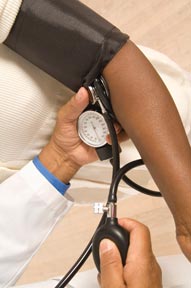Digging into the causes and fixes of resistant hypertension
An enduring challenge is figuring out why patients appear to have resistant hypertension and how to cure them of it.
Resistant hypertension has been clearly defined for quite a while, according to experts at the American Society of Hypertension's annual meeting, held in New York in May.
In 1978, Gifford and Tarazi defined the condition in Annals of Internal Medicine as blood pressure that remained elevated despite therapy with 3 drugs, 1 of which was a diuretic, at a substantial dose. The current American Heart Association definition includes blood pressure that remains above goal despite optimal doses of 3 agents of different classes, plus blood pressure controlled on 4 or more agents.

The enduring challenge is figuring out why patients appear to have resistant hypertension and how to cure them of it. At the meeting, David Hyman, MD, FACP, addressed the former, while John R. Cockcroft, MD, described innovative solutions to the latter.
To determine whether a patient has truly resistant hypertension, begin by asking, “Is the patient on a good drug regimen?” said Dr. Hyman, who is a professor at Baylor College of Medicine in Houston. “The data on this is actually pretty striking … the answer is probably no.”
Studies of patients with apparently resistant hypertension have shown that between 75% and 90% of them are on diuretics, but about 5% or fewer are taking an aldosterone antagonist, and many of the patients aren't at maximum doses of their medications, he reported. Only 3% or less are on chlorthalidone, the diuretic overwhelming preferred by experts in resistant hypertension.
“Unfortunately, unless someone is being taken care of by someone in this room, they're probably not on a good regimen, so we have a long way to go,” said Dr. Hyman.
Another question to consider is whether what appears to be resistant hypertension could actually be white-coat hypertension. “Twenty to 40% of people who appear to be resistant hypertensive, based on office blood pressure and drug regimen, will not be so on 24-hour ambulatory blood pressure monitoring,” said Dr. Hyman, noting that predictive models and home blood pressures have all been proven less effective than ambulatory monitoring at determining this, and brief in-office monitoring has not been tested.
The final, and biggest, question is patient adherence. How do you determine that? “It's pretty well established that clinician impression, direct questioning, [and] pill count are not very accurate,” Dr. Hyman said.
The gold standard for research purposes is electronic bottle cap monitoring, but that's likely not practical for practicing clinicians, he noted. Another option is therapeutic drug monitoring. “Blood and urine levels have been widely used in other areas of medicine and are making a comeback in hypertension,” he said.
These tests are generally available in the U.S. and are covered by many insurance companies. The problem is that they report anything above one-fifth to one-tenth the expected level of the drug. “If the patient has taken the drug any time in the last few half-lives of the drug, which for many of our drugs can be days to weeks, they'll probably test positive for the drug, which is passing,” said Dr. Hyman.
Another option is directly observed therapy. “If you take somebody, give them their blood pressure medicines, and you make them hypotensive, they were probably not adherent,” said Dr. Hyman. Research studies have kept patients in clinic for as long as 7 hours to do this, however, and there's the risk of hypotensive events, he noted.
That leaves looking into medication refills. “A refill record might be the strongest method readily available. Many of our EMRs now do it for us, and if you work with PharmDs they can do it. At least my experience has been that if you're the prescribing physician, if you call the pharmacy and ask if so-and-so has refilled, they'll tell you,” said Dr. Hyman.
Of course, once the cause of resistant hypertension has been identified, there's still the problem of how to fix it. “Can you change adherence? We would hope so, but it's hard,” Dr. Hyman said. “The real question is these apparent resistant uncontrolled hypertensives, particularly [those who are] nonadherent, are a very, very high-risk group, and what can we do to lower risk?”
There are several potential answers to that question in the works, according to Dr. Cockcroft, who is a professor of cardiology at the Wales Heart Research Institute in Cardiff, Wales, and a visiting professor at Columbia Presbyterian Hospital in New York.
The most well-known and thoroughly studied option is catheter-based renal denervation. Several speakers at the meeting discussed the disappointing results of the SYMPLICITY HTN-3 trial, published in the April 10, 2014, New England Journal of Medicine. “To cut a long story short … renal denervation did indeed lower blood pressure, but you got exactly the same reductions in the placebo arm,” said Dr. Cockcroft, noting that researchers are continuing to study the technique in the hopes of finding greater success.
One alternative might be to denervate from outside the body. “The kidney is identified using ultrasound, and then high-beam focused electric energy is directed at the renal nerves,” explained Dr. Cockcroft. In addition to being less invasive, this technique could potentially be more effective. “It may be that if you're doing it from the inside, you don't get complete denervation, whereas with the ultrasound denervation, the ablation volume extends 6 to 8 mm beyond the lumen and you've got potential for more complete ablation,” he said. Dr. Cockcroft is currently involved in a controlled trial of the treatment.
He's also studying central iliac arteriovenous anastomosis as a solution to resistant hypertension. The shunt between the iliac artery and iliac vein had previously been tested as a method to improve oxygenation in patients with obstructive pulmonary disease. “They found serendipitously that it did produce falls in blood pressure in these patients,” said Dr. Cockcroft. That led to a trial of the shunt in patients with resistant hypertension, positive results of which were published in the April 2015 Lancet.
Another novel option is neuromodulation, which has been used for refractory angina, pain management, Parkinson's disease, migraine, and epilepsy, Dr. Cockcroft noted. “Acupuncturists knew various points were good at varying blood pressure,” he said. A pilot study, presented at last year's Congress of the European Association of Percutaneous Cardiovascular Interventions, showed success with a peripheral nerve stimulator implanted in patients' forearms and programmed to stimulate for 30 minutes a week.
“There's a significant drop in systolic pressure in the office, and there's also a significant drop in 24-hour systolic pressure, post-activation of the system. Clearly this needs to be studied properly, and the study's being put together as we speak,” reported Dr. Cockcroft.
Two other possibilities under study are deep brain stimulation and carotid body denervation, but the research is in very early stages, Dr. Cockcroft cautioned. “I have to say in all honesty, I wouldn't be volunteering at this moment” to try either intervention, he said.




